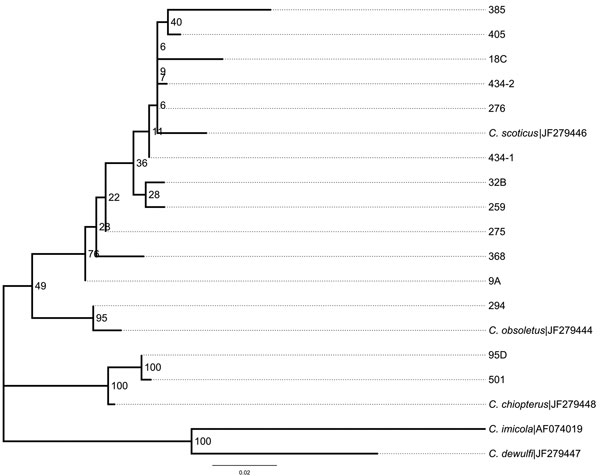Volume 19, Number 1—January 2013
Dispatch
Schmallenberg Virus in Culicoides spp. Biting Midges, the Netherlands, 2011
Figure

Figure. . Phylogenetic tree comparing Schmallenberg virus–positive Culicoides spp. biting midge abdomens isolated in different regions in the Netherlands, 2011, with reference sequences from Deblauwe et al. (7). C. imicola was used as an outgroup. Bootstrap values are indicated at the significant nodes. Scale bar indicates nucleotide substitutions per site.
References
- Saeed MF, Li L, Wang H, Weaver SC, Barrett ADT. Phylogeny of the Simbu serotype of the genus Bunyavirus. J Gen Virol. 2001;82:2173–81.PubMedGoogle Scholar
- Rasmussen LD, Kristensen B, Kirkeby C, Rasmussen TB, Belsham GJ, Bødker R, Culicoids as vectors of Schmallenberg virus [letter]. Emerg Infect Dis. 2012;18:1204–6. DOIPubMedGoogle Scholar
- Goffredo M, Meiswinkel R. Entomological surveillance of bluetongue in Italy: methods of capture, catch analysis and identification of Culicoides biting midges. In: MacLachlan NJ, Pearson JE, editors. Bluetongue, part 1, proceedings of the Third International Symposium, Taormina, 2003 Oct 26–29. Veterinaria Italiana. 2004;40:260–65.
- Bilk S, Schulze C, Fischer M, Beer M, Hlinak A, Hoffmann B. Organ distribution of Schmallenberg virus RNA in malformed newborns. Vet Microbiol. 2012;159:236–8. DOIPubMedGoogle Scholar
- Hoffmann B, Scheuch M, Höper D, Jungblut R, Holsteg M, Schirrmeier H, Novel orthobunyavirus in cattle, Europe, 2011. Emerg Infect Dis. 2012;18:469–72. DOIPubMedGoogle Scholar
- Cêtre-Sossah C, Baldet T, Delecolle JC, Mathieu B, Perrin A, Grillet C, Molecular detection of Culicoides spp. and Culicoides imicola, the principal vector of bluetongue (BT) and African horse sickness (AHS) in Africa and Europe. Vet Res. 2004;35:325–37. DOIPubMedGoogle Scholar
- Deblauwe I, De Witte JC, De Deken G, De Deken R, Madder M, Van Erk S, A new tool for the molecular identification of Culicoides species of the Obsoletus group: the glass slide microarray approach. Med Vet Entomol. 2012;26:83–91. DOIPubMedGoogle Scholar
- St George TD, Standfast HA, Cybinski DH. Isolation of Akabane virus from sentinel cattle and Culicoides brevitarsis. Aust Vet J. 1978;54:558–61. DOIPubMedGoogle Scholar
- St George TD, Standfast HA. Simbu group viruses with teratogenic potential. In: Monath TP, editor. The aboviruses: epidemiology and ecology. Vol. 4. Boca Raton (FL): CRC Press; 1989.
- Standfast HA, Dyce AL. Arthropods biting cattle during an epizootic of ephemeral fever in 1968. Aust Vet J. 1972;48:77–80. DOIPubMedGoogle Scholar
- Doherty RL, Carley JG, Standfast HA, Dyce AL, Snowdon WA. Virus strains isolated from arthropods during an epizootic of bovine ephemeral fever in Queensland. Aust Vet J. 1972;48:81–6. DOIPubMedGoogle Scholar
- Savini G, Goffredo M, Monaco F, Di Gennaro A, Cafiero MA, Baldo L, Bluetongue virus isolation from midges belonging to the Obsoletus complex (Culicoides, Diptera: Ceratopogonidae) in Italy. Vet Rec. 2005;157:133–9.PubMedGoogle Scholar
- Dijkstra E, van der Ven IJK, Hölzel DR, van Rijn PA, Meiswinkel R. Culicoides chiopterus as a potential vector of bluetongue virus in Europe. Vet Rec. 2008;162:422. DOIPubMedGoogle Scholar
Page created: December 20, 2012
Page updated: December 20, 2012
Page reviewed: December 20, 2012
The conclusions, findings, and opinions expressed by authors contributing to this journal do not necessarily reflect the official position of the U.S. Department of Health and Human Services, the Public Health Service, the Centers for Disease Control and Prevention, or the authors' affiliated institutions. Use of trade names is for identification only and does not imply endorsement by any of the groups named above.